AMD Ryzen 9 5980HS Cezanne Review: Ryzen 5000 Mobile Tested
by Dr. Ian Cutress on January 26, 2021 9:00 AM EST- Posted in
- CPUs
- AMD
- Vega
- Ryzen
- Zen 3
- Renoir
- Notebook
- Ryzen 9 5980HS
- Ryzen 5000 Mobile
- Cezanne
CPU Tests: Simulation
Simulation and Science have a lot of overlap in the benchmarking world, however for this distinction we’re separating into two segments mostly based on the utility of the resulting data. The benchmarks that fall under Science have a distinct use for the data they output – in our Simulation section, these act more like synthetics but at some level are still trying to simulate a given environment.
DigiCortex v1.35: link
DigiCortex is a pet project for the visualization of neuron and synapse activity in the brain. The software comes with a variety of benchmark modes, and we take the small benchmark which runs a 32k neuron/1.8B synapse simulation, similar to a small slug.
The results on the output are given as a fraction of whether the system can simulate in real-time, so anything above a value of one is suitable for real-time work. The benchmark offers a 'no firing synapse' mode, which in essence detects DRAM and bus speed, however we take the firing mode which adds CPU work with every firing.
The software originally shipped with a benchmark that recorded the first few cycles and output a result. So while fast multi-threaded processors this made the benchmark last less than a few seconds, slow dual-core processors could be running for almost an hour. There is also the issue of DigiCortex starting with a base neuron/synapse map in ‘off mode’, giving a high result in the first few cycles as none of the nodes are currently active. We found that the performance settles down into a steady state after a while (when the model is actively in use), so we asked the author to allow for a ‘warm-up’ phase and for the benchmark to be the average over a second sample time.
For our test, we give the benchmark 20000 cycles to warm up and then take the data over the next 10000 cycles seconds for the test – on a modern processor this takes 30 seconds and 150 seconds respectively. This is then repeated a minimum of 10 times, with the first three results rejected. Results are shown as a multiple of real-time calculation.
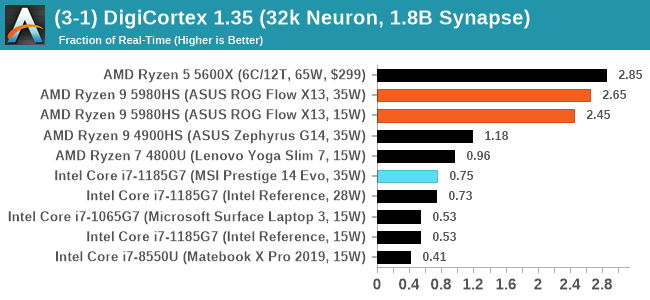
DigiCortex seems to have taken a shine to Zen 3, especially processors with a single chiplet of cores. Intel can't seem to compete here.
Dwarf Fortress 0.44.12: Link
Another long standing request for our benchmark suite has been Dwarf Fortress, a popular management/roguelike indie video game, first launched in 2006 and still being regularly updated today, aiming for a Steam launch sometime in the future.
Emulating the ASCII interfaces of old, this title is a rather complex beast, which can generate environments subject to millennia of rule, famous faces, peasants, and key historical figures and events. The further you get into the game, depending on the size of the world, the slower it becomes as it has to simulate more famous people, more world events, and the natural way that humanoid creatures take over an environment. Like some kind of virus.
For our test we’re using DFMark. DFMark is a benchmark built by vorsgren on the Bay12Forums that gives two different modes built on DFHack: world generation and embark. These tests can be configured, but range anywhere from 3 minutes to several hours. After analyzing the test, we ended up going for three different world generation sizes:
- Small, a 65x65 world with 250 years, 10 civilizations and 4 megabeasts
- Medium, a 127x127 world with 550 years, 10 civilizations and 4 megabeasts
- Large, a 257x257 world with 550 years, 40 civilizations and 10 megabeasts
DFMark outputs the time to run any given test, so this is what we use for the output. We loop the small test for as many times possible in 10 minutes, the medium test for as many times in 30 minutes, and the large test for as many times in an hour.
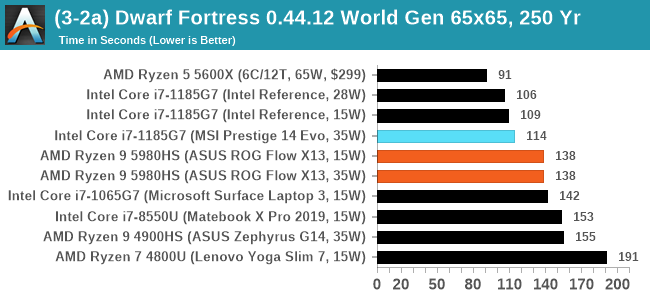
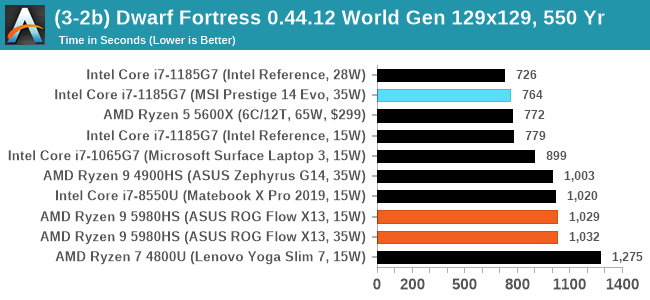
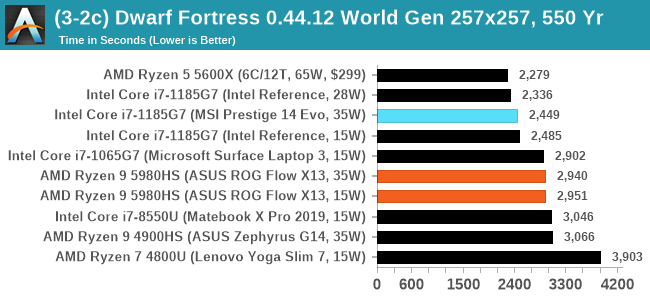
DF has historically been an Intel favorite, and we're not seeing much of a speedup for mobile Zen 3 over mobile Zen 2 here.
Dolphin v5.0 Emulation: Link
Many emulators are often bound by single thread CPU performance, and general reports tended to suggest that Haswell provided a significant boost to emulator performance. This benchmark runs a Wii program that ray traces a complex 3D scene inside the Dolphin Wii emulator. Performance on this benchmark is a good proxy of the speed of Dolphin CPU emulation, which is an intensive single core task using most aspects of a CPU. Results are given in seconds, where the Wii itself scores 1051 seconds.
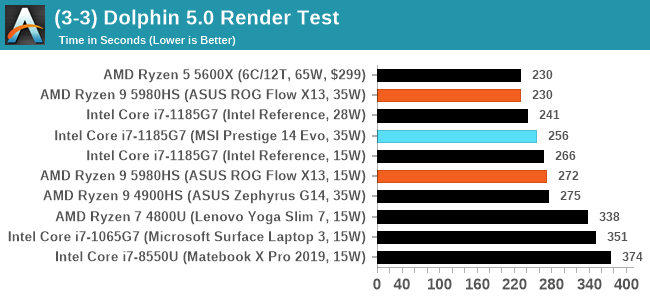
The 35W variant of Cezanne pushes through here, matching the desktop processor, and a sizeable performance jump over the previous generation Renoir.












218 Comments
View All Comments
Lemnisc8 - Tuesday, January 26, 2021 - link
Can someone PLEASE find out if this thing is running in quad channel or dual channel lpddr4x. It’s already at a disadvantage since lpddr4x has half the bus width of standard ddr4. It would be fine if it ran in quad channel because it’s bus width would then be the same size as ddr4 at 128 bits, but no reviews anywhere show what channel configuration it’s running in...neblogai - Tuesday, January 26, 2021 - link
I don't think there were any 4000-series laptops running LPDDR4x just dual channel- I've only seen it to be quad-channel. So this flagship device (and used by AMD to impress about 5000H performance) should be no different.xza23 - Tuesday, January 26, 2021 - link
As always , excellent article , thank you!watzupken - Tuesday, January 26, 2021 - link
I feel with the introduction of Renoir, what blew most away is the fact that AMD managed to squeeze 8 cores into the U series. Not only that, the Zen 2 architecture also resulted a some serious uplift in performance as compared to the previous Zen+. This year round while it is all nice and good to see decent performance bump, the wow factor is not there. I am not expecting a core increase especially on the same N7 node, and to be honest, 8 cores is plenty of performance for a mobile PC.On the point of still using Vega, despite the age, Vega is still very competitive. One may argue that Intel's Xe graphics is better, but reviews out there proved otherwise. Xe is certainly fast, but both the iGPUs from AMD and Intel are likely memory bandwidith limited if one is pushing 1080p. Adding more cores will likely have diminishing returns. And honestly if you are a gamer, you cannot avoid getting a system with a dedicated GPU no matter how good the iGPU is.
Fulljack - Wednesday, January 27, 2021 - link
I agree, the R&D cost of moving from Vega to RDNA probably isn't worth it in the grand scheme of business.rumor has it that in 2022, Rembrandt will still leverage Zen 3 CPU but will use RDNA2 with DDR5 memory.
Ptosio - Wednesday, January 27, 2021 - link
Shouldn't it be pretty straightforward given that these APU already kind-of exist in the consoles?Hopefully Alder Lake would push AMD to offer best CPU/GPU combination they have!
As I understand, going to RDNA2 would also mean smaller core for the same performance? So there should be some savings in it for AMD as well.
Spunjji - Thursday, January 28, 2021 - link
"Shouldn't it be pretty straightforward given that these APU already kind-of exist in the consoles?"Those APUs use a totally different memory subsystem, much larger GPU slices, and they also use Zen 2 cores. AMD were specifically aiming to get Zen 3 out across their range - there's probably a lot of work needed to scale RDNA 2 down to iGPU levels without unbalancing its performance.
zamroni - Tuesday, January 26, 2021 - link
Amd should reduce Cezanne's core count to 6 then use the transistor budget for more gpu cores.That way it will beat all Intel laptop processors at all aspects
dicobalt - Tuesday, January 26, 2021 - link
Now they need to sell a version that cuts out the silly integrated graphics and uses a faster dedicated GPU. I don't understand the motivation for having a steroid pumped 8 core CPU paired with anemic integrated graphics. It seems AMD is more interested in selling the idea of APUs than actually providing a balanced system.Zizy - Wednesday, January 27, 2021 - link
AMD is clear that integrated GPU is for the very same chip at 15W. It is a pretty fine GPU there, TDP and bandwidth limit potential anyway. I wonder what is the die area saving by ditching GPU. If it is sizeable then yeah, it would be great to have a GPU-less variant of the chip, especially with current wafer supply issues.